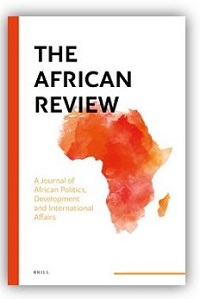A Proposed Structure of the Union in Tanzania: Political Parties at a Crossroad
Abstract
This article focuses on the implications of a particular constitutional design of decentralization on the behaviour of political parties as representative institutions. As Tanzania seeks to enact a new constitution, the proposed changes in the Draft Constitution of 2013 on the structure of the United Republic of Tanzania will most likely lead to new trends on how political parties organize, compete, cooperate and mobilize electoral support. The article argues that whereas a two-tier government model has been able to compel political parties to forge broad-based fronts thereby leading to national stability, on the other side, it has not adequately addressed issues and interests of the constituent governments partly due to its centralized party system. The proposed three-government model has expanded avenues of people ' s participation in decision-making processes but without addressing the mechanisms through which political parties will be compelled to promote coalition-building, national consensus and political stability.References
Beramendi, P. 2007. "Federalism" in C. Boix and S. Stokes (eds) The Oxford Handbook of Comparative Politics. Oxford: Oxford University Press.
Bakary, A. K. 2006. "The Union and the Zanzibar Constitutions" in Peter, C. M. and O. Haroub (eds) Zanzibar and the Union Question. Zanzibar Legal Services Center Publication Series, Book No. 4.
Chhibber, P. and Kollman, K. 2004. The Formation of national Party systems: federalism and Party Competition in Canada, Great Britain, India and the United States, Princeton: Princeton University Press.
Desposato, S. 2004. "The Impact of federalism on National Party Cohesion in Brazil", Legislative Studies Quarterly, XXIX: 259-85.
Duverger, M. 1964. Political Parties: Their Organization and Activity in the Modern States, London: Methuen.
ESAURP. 2004. MUAFAKA: The Roots of Peace in Zanzibar. Dar es Salaam: TEMA Publishers.
Gastorn, K. 2013. ' Discussion on the Proposed Amendments to the Political Parties Act, 1992 ' A paper submitted in a conference organized by the Registrar of Political Parties in Tanzania, September.
Gerring, J. et al. 2007. "Are Federal Systems Better than Unitary Systems?", Unpublished paper, www.bu.edu/files/2012/01 (accessed: December 8, 2013).
Hamad, S. S. 2007. "The Union ' s Problems and How to resolve them: CUF Perspective" in REDET (ed) The Union of Tanzania: Success, Problems and Solutions, REDET Book series, No. 15.
Juan, L. and Stepan, A. 1998. Toward Consolidated Democracies" in L. Diamond (ed) Developing Democracies, Baltmore, Maryland: John Hopkins University Press.
Makaramba, R. 1997. A New Constitutional Order for Tanzania: Why and How?, Tanganyika Law Society Book Series.
Mayer, L. 1970. "Federalism and Party behavior in Australia and Canada" The Western Political Quarterly, 23(4): 795-807.
Mushi, S.S. 2004. "Historical and Theoretical Analysis of Representation" in R.S. Mukandala et al. (eds) People ' s Representatives: Theory and Practice of Parliamentary Democracy in Tanzania.Kampala: Fountain Publishers.
National Electoral Commission 2010. The Report of the National Electoral Commission on the 2010 Presidential, Parliamentary and Councillors ' Elections, NEC, Tanzania
Nyerere, J.K. 1995. Our leadership and the Destiny of Tanzania. Zimbabwe: Zimbabwe Publishing House.
Peter, C. M. and Othman, H. (eds) 2006. Zanzibar and the Union Question. Zanzibar legal Services Centre Publication Series.
Pitkin, H. 2004. "Representation and Democracy: Uneasy Alliance", Scandinavian Political Studies, 27(3): 335-42.
Pitkin H. 1967. The Concept of Representation. Berkeley, Los Angeles: University of California Press.
Pollack, J. et al. 2009. "On Political Representation: Myths and Challenges", RECON Online Working Paper, No. 3 www.reconproject.eu/(accessed: February 10, 2014).
Ross, C. 2000. "Political Parties and Regional Democracy in Russia" A paper presented at the Political Studies Association, London.
Schwindt-Bayer, L. et al. 2002. The Nexus of Representation: An Integrated Model of Women ' s Representation" A conference paper, August www.u.arizona.edu/ (accessed: February 12, 2014)
Sherrif, A. 1994. "The Union and the Struggle for Democracy in Zanzibar" in R. Mukandala and H. Othman (eds) Liberalization and Politics: The 1990 Election in Tanzania, Dar es Salaam: Dar es Salaam University Press.
Shivji, I. 1990. The Legal Foundations of the Union in Tanzania ' s Union and Zanzibar Constitutions. Dar es Salaam: Dar es Salaam University Press.
Skinner, Q. 2005. "Hobbes on Representation," European Journal of Philosophy, 13 (2): 155-84.
Srivastava, B.P. 1983. The Constitution of the United Republic of Tanzania 1977: Some Salient Features, Some Riddles. Dar es Salaam: Dar es Salaam University Press.
TEMCO. 2000. The 2000 General Elections in Tanzania. University of Dar es Salaam.
The United Republic of Tanzania. 2005. The 1977 Constitution of the United Republic of Tanzania, Dar es Salaam, Tanzania
The United Republic of Tanzania. 2014. The Constitutional Review Act, Revised edition 2014, Dar es Salaam, Tanzania
The United Republic of Tanzania. 2013. The Draft Constitution of the United Republic of Tanzania, Dar es Salaam, Tanzania
The Revolutionary Government of Zanzibar. 2010. The 1984 Zanzibar Constitution, Zanzibar.
Thorlakson, L. 2010. "Party Organizational Strategy in Multi-Level Systems" A paper presented to the 2010 Canadian Political Science Association Annual Conference, Montreal, Quebec, 1-3 June www.cpsaacsp/papers-2010/Thorlakson.pdf (accessed: February, 12 2014).
Urbinati, N. and Warren, M. 2008. "The Concept of Representation in Contemporary Democratic Theory", The Annual Review of Political Science, 11: 387-412.
Waylen, G. et al. 2013. Oxford Handbook of Gender and Politics. Oxford: Oxford University Press.
Downloads
Published
Issue
Section
License
Copyright © by Department of Political Science and Public Administration, University of Dar es Salaam
All rights reserved. No part of this publication may be reproduced or transmitted in any form or by any means, electronic or mechanical, including photocopying, recording, or any information storage or retrieval system, without permission in writing from the publisher, except for short extracts in fair dealing, for research or private study, critical scholarly review or discourse with an acknowledgement.
The African Review: A Journal of African Politics, Development and International Affairs [ISSN 0856-0056 (Print) & ISSN 1821-889X (Online)] is published bi-annually, June and December by the Department of Political Science and Public Administration, University of Dar es Salaam, P.O. Box 35042 €“ Dar es Salaam €“ Tanzania



